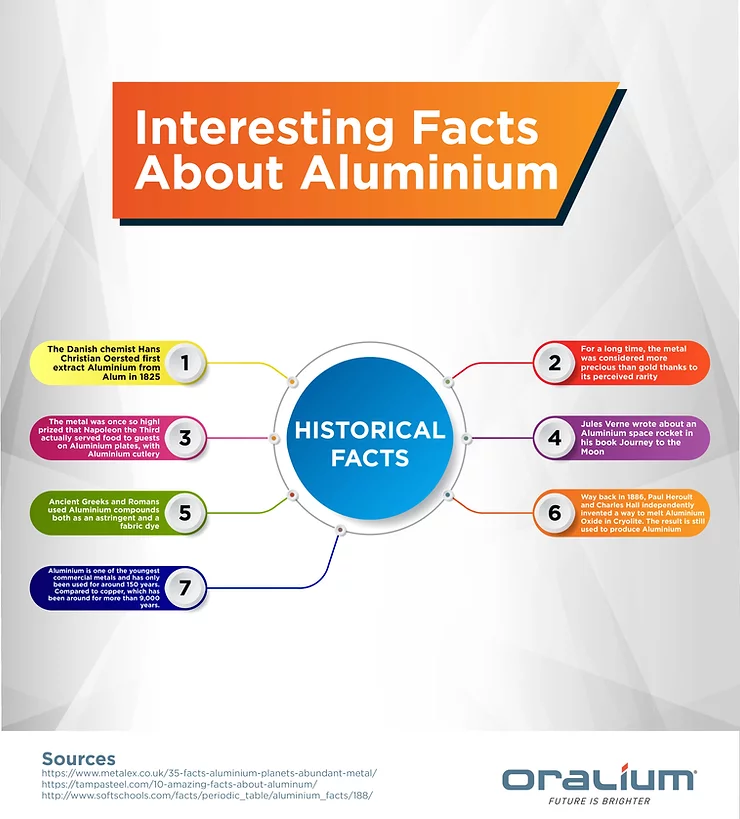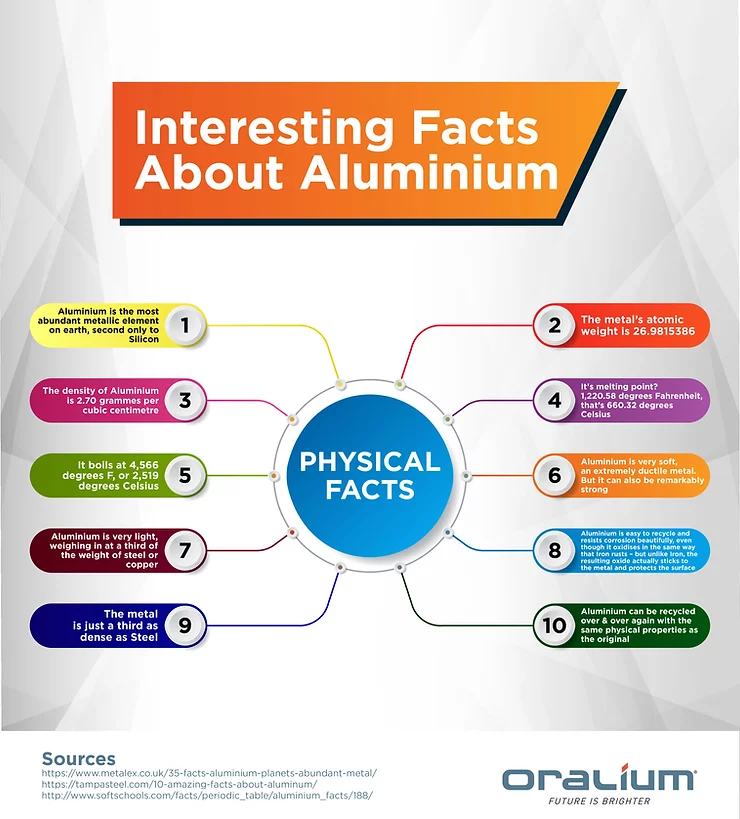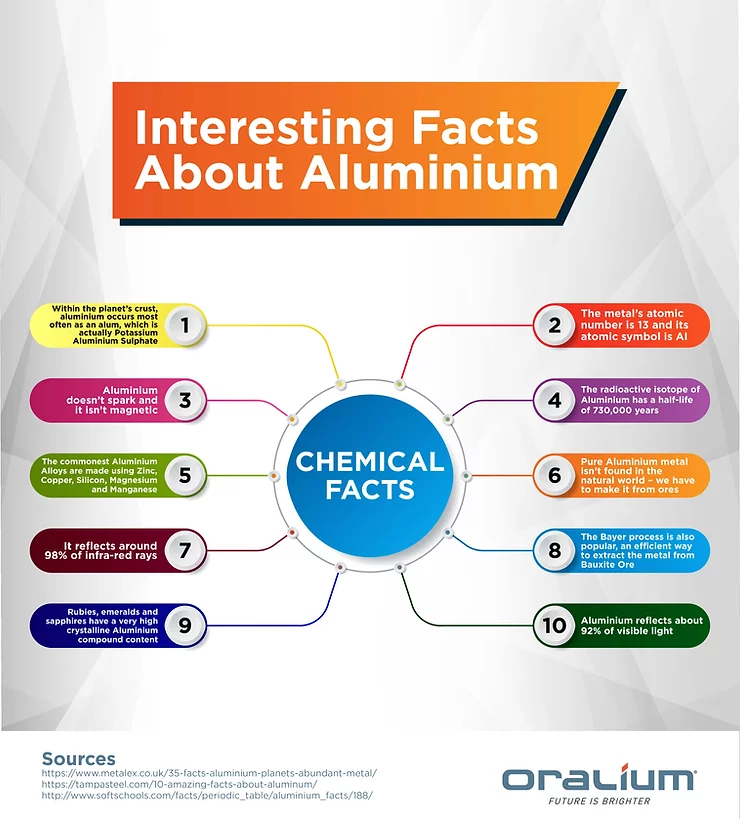40 Interesting facts about Aluminium you probably didn't know!
Aluminium is not just found wrapped around leftover food in the refrigerator. It is the second most abundant element on Earth, it is used in soda cans, making jet planes and other vehicles and is also used to make roofing sheets, providing shelter to a multitude of people all over the globe. The impact of Aluminium metal is so profound that the present age can rightly be called “The Age of Aluminium.” Aluminium is increasingly finding widespread use due to its unique qualities. Read on some of the most interesting facts about Aluminium:
General Facts
What is the first thought that comes to your mind when you think about aluminium? Most of us, we tend to think about aluminium foil, sheets and other more basic uses of the metal. Aluminium, however, is an extremely interesting metal if you really know about it. Did you know 8% of Earth’s crust is made out of Aluminium or our very own Moon contains Aluminium in a considerable quantity.
- Australia is the world’s leading producer of Aluminium.
- A Boeing-747 contains 66,000 kg of the metal.
- 8% of the planet’s crust is Aluminium.
- The moon contains a great deal of Aluminium.
- There are literally 100s of different Aluminium Alloys.
- Recycling Aluminium takes just 5% of the energy used to extract fresh aluminium from ore.
- NASA deep space researchers have harnessed Al-26 to spot supernovas.
.jpg)
Historical Facts
According to our history books, Danish Chemist, Hans Christian Oersted is the founder of Aluminium. It was considered so precious that at one point of time in history, Napoleon the Third actually used it in his home as precious cutlery. Then, In the 20th century, the industrial production of aluminium was started, as it began to be highly valued for its unique properties & we haven’t looked back since.
- The Danish chemist Hans Christian Oersted first extract Aluminium from Alum in 1825.
- For a long time, the metal was considered more precious than gold thanks to its perceived rarity.
- The metal was once so highly prized that Napoleon the Third actually served food to guests on Aluminium plates, with Aluminium cutlery.
- Jules Verne wrote about an Aluminium space rocket in his book Journey to the Moon.
- Ancient Greeks and Romans used Aluminium compounds both as an astringent and a fabric dye.
- Way back in 1886, Paul Heroult and Charles Hall independently invented a way to melt Aluminium Oxide in Cryolite. The result is still used to produce Aluminium.
- Aluminium is one of the youngest commercial metals and has only been used for around 150 years. Compared to copper, which has been around for more than 9,000 years.

Physical Facts
Aluminium is the 3rd most abundant element on the planet's crust. It is a shiny, silvery white-coloured metal that is light in weight but very strong. The density of aluminium is 2.7 g/mL, meaning the metal will sink in water but is still relatively light in weight. Did you know Aluminium weighs just one-third that of Steel?
- Aluminium is the most abundant metallic element on earth, second only to Silicon.
- The metal’s atomic weight is 26.9815386.
- The density of Aluminium is 2.70 grammes per cubic centimetre.
- The melting point 1,220.58 degrees Fahrenheit, that’s 660.32 degrees Celsius.
- It boils at 4,566 degrees F, or 2,519 degrees Celsius.
- Aluminium is very soft, an extremely ductile metal. But it can also be remarkably strong.
- Aluminium is very light, weighing in at a third of the weight of steel or copper.
- Aluminium is easy to recycle & is corrosion resistant, it oxidises in the same way that Iron rusts, but oxide actually sticks to the metal and protects the surface.
- The metal is just a third as dense as Steel.
- Aluminium can be recycled over & over again with the same physical properties as the original.

Chemical Facts
Aluminium metal’s atomic number is 13 & its atomic symbol is “Al”. Aluminium is a chemically wonderful metal. The metal has great chemical properties which make it a perfect metal to be used in the manufacturing of various applications in our day-to-day lives. Did you know Aluminium doesn’t spark and it isn’t magnetic? Want to know more about the chemical properties of this versatile metal?
- Within the planet’s crust, aluminium occurs most often as an alum, which is actually Potassium Aluminium Sulphate.
- The metal’s atomic number is 13 and its atomic symbol is AI.
- Aluminium doesn’t spark and it isn’t magnetic.
- The radioactive isotope of Aluminium has a half-life of 730,000 years.
- The commonest Aluminium Alloys are made using Zinc, Copper, Silicon, Magnesium and Manganese.
- Pure Aluminium metal isn’t found in the natural world – we have to make it from ores.
- It reflects around 98% of infra-red rays.
- The Bayer process is also popular, an efficient way to extract the metal from Bauxite Ore.
- Rubies, emeralds and sapphires have a very high crystalline Aluminium compound content.
- Aluminium reflects about 92% of visible light.

Application Facts
All types of instruments & vehicles, from bikes to spaceships, are made from aluminium. This versatile metal allows people to move at lightning speeds, cross oceans, fly in the sky and even leave our planet. This metal is in our surroundings so much that about 75% of all aluminium ever made is still in circulation, present in our world in some form.
- About 75% of all Aluminium ever made is still circulating, still in use.
- The metal is almost always used as an alloy, even if it’s more than 99% aluminium.
- An Aluminium drinks can take just 60 days to go from your bin to being recycled into a new can.
- In 2012 alone, 1.9 million tons of Aluminium was used to make containers and packaging.
- Recycle a single can made from the metal and you save enough energy to run your TV for three hours.
- In 2012, according to the U.S. Environmental Protection Agency (EPA),1.7 million tons went toward appliances, vehicle parts and other durable goods.
